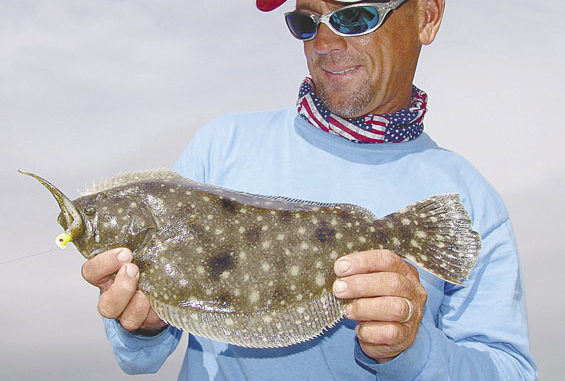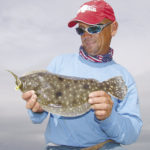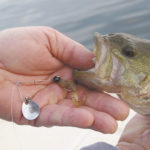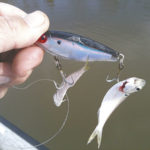
Wondering what to throw this month in the salty marsh? Take a look in your freshwater box.
A lot of fisherman in the Carolinas go both ways — that is, they target both freshwater and saltwater species of fish throughout the year.
So it makes perfect sense for those anglers to get the most out of every lure they purchase. That means stocking the tackle box with artificial baits that are effective for largemouth bass, stripers, redfish, seatrout, and bluefish, among others.
That might seem like a tall order for any particular lure, but the fact is, baitfish ranging from shad to blueback herring and finger mullet all look somewhat alike; they are all silver and shiny. Moreover, freshwater panfish like perch have
a more rounded shape, size and coloration like saltwater pinfish. Crawfish, crabs and shrimp share some amazing visual appendage similarities as well.
Sure, there are significant differences between the various shapes and sizes between these primary forage species, but there is a great deal of variation within each species as well. That’s one of the reasons lures work so well.
Plus, lures have become more realistic than ever. Anglers have never had more choices than they do between some of the classics that have worked for decades and new lures that feature amazing details.
Topwater baits, spinnerbaits, jigs and spoons are catching fish every day across both states in all types of situations. The reason: fish are pretty stupid, according Capt. George Beckwith of Down East Guide Service in Morehead City, N.C.
“I don’t think fish are as smart as most people do. For them, it’s all about accumulating protein,” he said.
Beckwith, a prolific guide and former pro bass fisherman with a degree in marine biology to back up his extensive angling experience, believes the biggest difference between the challenge of fishing in freshwater versus saltwater is the mere size of the fishery, not what lure you are using.
“The (saltwater) system is so much bigger. It is more about being in the fish than what you are throwing,” he said. “Plus, saltwater fish aren’t as picky.”
For that reason, he thinks freshwater lures are more prone to work in saltwater, than vice-versa. For him, the Johnson Beetle Spin is his first choice. He proved it by casting the lure to a small jetty near the junction of the Neuse River and Pamlico Sound and pulling back a nice flounder, followed shortly by a redfish and a croaker.
“All you have to do is drag it along the bottom,” he said. “If you’re not dragging the bottom you’re not getting bit.”
Heddon’s Zara Spook is one of Beckwith’s all-time favorites as well, especially when it comes to fishing for speckled trout, bluefish and striped bass. There isn’t a logical reason why one of Bomber’s new Badonk-A-Donk topwater baits wouldn’t work for largemouth bass in most freshwater situations, especially those in stained water when the fish aren’t going to get a good look at the bait anyway.
Taking a highly realistic, saltwater-specific lure to a lake environment could be a very successful strategy, though you might consider switching out the saltwater-grade hooks for more stealthy hooks made for freshwater fishing.
Beckwith has one particular lure in mind when it comes to something he would throw to largemouth bass that don’t want to bite.
“The MirrOlures, the MR17s, that’s probably as technical an inshore lure that is made,” he said. “It is designed to catch speckled trout, which at times can be very finicky. And you need a lure that is designed to suspend right in their face. You can take it over to freshwater and I think it would be super effective.”
An even more versatile option would be jigs with soft-plastic baits. Beckwith throws these to Roanoke River stripers each spring, bass pros are using them for swim baits at tournaments across the United States, and Capt. J.R. Waits of Fish Call Charters in Isle of Palms, S.C., uses them regularly with Gulp! scented soft plastics to catch redfish all year — a pretty amazing variety for such a simple lure. Of course, it’s all possible thanks to the spectacular array of soft-plastic baits that are on the
market today.
Then, there are the spoons. In particular, the Hopkins spoon is a classic that stands out for Jim Weaver of The Bait Shop in Anderson, S.C. He has been striper fishing since the 1960s, with extensive time on Santee-Cooper and Lake Hartwell in South Carolina, and Badin and Buggs Island (Kerr) Lake in North Carolina. Moreover, he has been a flats guide in Crystal River, Fla., for redfish, snook, tarpon and trout.
“The Hopkins Spoon is absolutely the most versatile lure ever made for fresh and saltwater,” Weaver said. “I’ve never figured out why all fish seem to love a hammered piece of metal, but they do. And I’ve been more successful with that and caught tens of thousands of fish on that spoon. If I was limited to one lure the rest of my life it would be the Hopkins spoon.”
Again, versatility and simplicity are what makes these spoons stand out like the Beetle Spin and the Spook. “It’s a great trolling lure in saltwater,” said Weaver. “And no matter how you’re fishing, you’re crazy if you don’t have one rod ready at all times to throw to a breaking fish. And I have a ¾-ounce Hopkins Spoon that’s my throwing lure if I see a big fish break anywhere near the boat.
“In saltwater, they work as well vertical jigging as they do in freshwater,” he added. “I can’t tell you how many trips I’ve had where we get nothing on the live bait and we get 100 fish jigging a Hopkins Spoon. They’re amazing.”
Weaver echoes Beckwith’s sentiments on how fish perceive these simple lures.
“It’s a reactionary lure. They only have a split second to decide. And it’s pretty hard to resist the flash and the action of these things,” he said.
“If you’re trolling, you have a nice side-to-side, swimming-fish motion. “But if you’re vertical jigging, it looks like a dying bait fish. Vertical jigging — you get most of your hits when it is fluttering downwards. It is simplicity at its best. I’m a firm believer in that.”
Certainly, both bass fisherman and inshore saltwater fisherman will agree that catching fish is a whole lot more fun than simply casting and retrieving all day with nothing to show for it. And those days definitely outnumber the days where the fish are jumping in the boat. Still, there are certain fisherman that would rather catch just a few fish on artificials rather than sheer numbers on live or cut bait.
“You can catch saltwater fish on bass lures,” said Beckwith, who, after catching several small fish on his Beetle Spin, rigged a big, fresh shrimp on a jig on threw it out to the same jetty, just to make a point. As soon as it hit the water he came tight to a 4-pound speckled trout that absolutely exploded on the bait. That fish had ignored repeated casts with the Beetle Spin and several topwater lures before hitting the shrimp. “But why would you want to?”






Be the first to comment